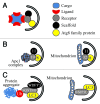Receptor protein complexes are in control of autophagy
- PMID: 22874568
- PMCID: PMC3494607
- DOI: 10.4161/auto.21332
Receptor protein complexes are in control of autophagy
Abstract
In autophagic processes a variety of cargos is delivered to the degradative compartment of cells. Recent progress in autophagy research has provided support for the notion that when autophagic processes are operating in selective mode, a receptor protein complex will process the cargo. Here we present a concept of receptor protein complexes as comprising a functional tetrad of components: a ligand, a receptor, a scaffold and an Atg8 family protein. Our current understanding of each of the four components and their interaction in the context of cargo selection are considered in turn.
Keywords: Atg8 family protein; autophagic cargo; ligand; phagophore; receptor; scaffold protein.
Figures

References
Publication types
MeSH terms
Substances
Grants and funding
LinkOut - more resources
Full Text Sources
